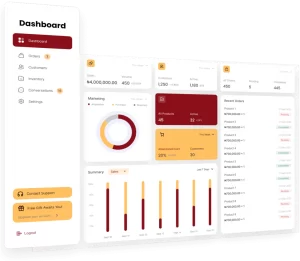Have you encountered difficulties in managing inventory effectively as a manufacturer in the dynamic industrial landscape of the Philippines?
For many manufacturers, the complexities of inventory control present significant challenges that affect production efficiency, costs, and overall business performance. In a competitive market like the Philippines, where efficient resource allocation is essential for sustained growth, the importance of streamlined inventory management practices cannot be overstated.
Kung nararanasan mo ang mga hamong ito, nasa tamang lugar ka. Sa artikulong ito, tatalakayin namin ang mga praktikal na tips sa pamamahala ng imbentaryo upang makatulong na mapahusay ang iyong kahusayan at mapabuti ang iyong operasyon dito sa Pilipinas.
Table of Contents

Key Takeaways
|
1. Set up Minimum Inventory levels
Simplify industrial inventory management by establishing ‘par levels,’ which represent the minimum amount of inventory that must always be on hand. When items reach or approach these set minimum levels, it signals the need to reorder.
Ideally, orders should be placed in quantities that exceed these minimum levels. The appropriate minimum inventory level for each product will vary based on factors such as sales velocity and delivery lead time.
The most effective way to manage inventory levels is to use inventory solutions for specific industries, including those designed for industrial settings like salons and spas.
These specialized software solutions not only help maintain optimal stock levels but are also equipped to handle the unique inventory needs, such as tracking various beauty products, monitoring usage and expiration dates, and managing restocking schedules. Manufacturing inventory software offers similar capabilities tailored to industrial production environments.
2. Conduct Demand Forecasting
To determine the ideal amount of inventory to keep on hand and avoid unnecessary purchases, overstock, or stockouts, it is essential to forecast product demand. Manufacturers can approach demand forecasting by considering various internal and external factors, including:
- Market trends
- Last year’s sales data
- This year’s growth rate
- Overall economic conditions
- Upcoming promotions
- Planned advertising expenditures
When using historical sales data, it’s crucial to ensure the data is comprehensive and accurate to avoid errors in forecasting. A robust manufacturing inventory management system with forecasting capabilities can generate precise forecasts to support better decision-making for future purchases.
This feature not only helps predict demand but also optimizes inventory levels effectively. Interested in exploring these advanced features and their pricing? Click the banner below to learn more about HashMicro’s manufacturing inventory management system and discover how it can enhance your inventory management strategy.

3. Use FIFO Method
First-in, first-out (FIFO) is an essential principle in manufacturing inventory management. It ensures that the oldest stock (first-in) is sold before the newer stock (first-out). This practice is particularly crucial for perishable items to prevent unsaleable goods.
The FIFO method can also be applied to non-perishable products. If older items are consistently pushed to the back, they may become obsolete more quickly. Selling outdated products is something every business wants to avoid.
To effectively implement the FIFO principle, it is important to maintain an organized warehouse by placing new stock at the back or ensuring older stock remains at the front.
4. Audit & Conduct Regular Inventory Inspections
Regularly reviewing and conducting inventory audits is the best way to identify potential issues before they arise. Ideally, manufacturers should perform audits and inspections every month to ensure full coverage of their inventory.
The most efficient way to verify your inventory data is by using inventory management software to generate reports, which show the quantity of products on hand. However, it’s crucial to ensure that the system-recorded quantities align with the physical count of goods. There are several methods for conducting inventory audits, including:
Physical inventory
Physical inventory involves counting all your stock at once. Many businesses conduct this process at the end of the year, as it aligns with accounting practices and income tax filing.
Although manufacturers typically perform physical inventory once a year, it can be disruptive to business operations.
This method is often considered less efficient compared to other inventory tracking methods. If discrepancies are found, it can be challenging to pinpoint the issue, as it requires reviewing an entire year’s worth of records.
Spot checking
If you conduct a full physical inventory at the end of the year and frequently encounter issues, or if you manage a large number of products, consider performing spot checks throughout the year.
This involves selecting a product, counting it, and comparing the actual count to the expected quantity. Spot checks do not need to follow a fixed schedule and serve as a complement to the annual physical inventory.
Cycle counting
Instead of performing a full physical inventory, some businesses use cycle counting to audit their stock. Rather than conducting a complete count at the end of the year, cycle counting allows you to regularly verify the system’s inventory numbers against the actual stock throughout the year.
Manufacturers can carry out cycle counting as needed—daily, weekly, or monthly. Different products are counted in rotation according to a set schedule. Various methods can be used to determine how often a product should be counted, with higher-value items typically being counted more frequently.
5. Use ABC Analysis
Certain products require more focus than others. Use ABC analysis to prioritize your inventory management by classifying products based on their needs. Review your product list and categorize each item into one of the following three groups:
- A: High-value products with low sales frequency
- B: Moderately valuable products with moderate sales frequency
- C: Low-value products with high sales frequency
Products in category A demand more attention due to their significant financial impact, though their sales are less predictable. In contrast, products in category C require less oversight because they have a lower financial impact and sell more frequently. Products in category B fall in between these two extremes.
6. Manage Good Relationships with Suppliers
Building strong relationships with suppliers is an effective way to maintain control over your inventory. With a solid partnership, suppliers will be more inclined to collaborate with you to resolve any inventory management issues that may arise for manufacturing companies.
Good supplier relationships are highly beneficial. Manufacturers can negotiate minimum order quantities, so don’t hesitate to request lower minimums to reduce the need for excess inventory. Managing supplier relationships can be made easier by adopting a supply chain management system.
A strong relationship is not only about being cordial but also about maintaining clear communication. Inform your suppliers in advance if you expect an increase in sales, allowing them to adjust their supply levels according to your production plans.
Additionally, ask them to notify you if there are any delays in product delivery, so you can adjust your production and promotional schedules accordingly.
7. Supplier Collaboration and Relationship Management
Building strong partnerships and maintaining effective relationships with suppliers is crucial for efficient inventory management in manufacturing. By working closely with reliable suppliers, manufacturers can significantly improve their inventory processes. One of the key benefits of such collaboration is the ability to shorten lead times and ensure timely deliveries.
This partnership facilitates better communication, allowing manufacturers to share important information such as sales data, demand forecasts, and production schedules with their suppliers. This exchange of information helps improve inventory planning and enables suppliers to adjust their production and delivery schedules accordingly.
As a result, manufacturers can minimize the risk of stockouts or overstocking, leading to a more efficient inventory management system. Additionally, negotiating favourable terms, such as flexible delivery schedules or pricing, can help manufacturers save costs and enhance operational efficiency in the Philippines.
8. Implement RFID Technology for Inventory Tracking
Implementing Radio-Frequency Identification (RFID) technology offers a transformative solution for inventory management, particularly in manufacturing. RFID tags act as digital identifiers, storing unique data about products, components, or raw materials.
These tags use radio waves to wirelessly transmit data to RFID readers or antennas placed throughout the production line, warehouse, or storage areas. This technology allows manufacturers systems to track inventory movements in real-time as items move through various stages of production or storage.
Unlike traditional barcode systems, RFID does not require direct line-of-sight scanning and can scan multiple items at once, significantly reducing the time spent on inventory checks and manual data entry. Additionally, RFID improves accuracy by reducing human errors, ensuring precise inventory counts, and minimizing the risk of stock discrepancies or misplaced items.
With real-time, accurate visibility into inventory levels, manufacturers can make informed decisions quickly, leading to better resource allocation, optimized production schedules, and improved order fulfilment.
By adopting RFID technology with manufacturing ERP software, manufacturers in the Philippines can enhance operational efficiency, reduce inventory holding costs, and create a more agile manufacturing environment.
Improve Inventory Management Efficiency with HashMicro’s System
Integrating HashMicro’s inventory management system is an effective solution to enhance inventory management efficiency. This system is specifically designed to help users manage inventory through a range of comprehensive features. Additionally, it offers a free demo that you can access anytime to better understand how the system operates.
Here are the key features of the HashMicro inventory management system that make it an ideal choice:
- RFID Warehouse Rack Stock Automation: Automates the tracking of stock movements in and out of warehouse racks, improving both efficiency and accuracy in inventory management.
- 3D Warehouse: Assists in planning product placement, optimizing space usage, and identifying logistical challenges.
- Stock Forecasting: Allows you to proactively reorganize stock, optimize inventory levels, and enhance customer satisfaction.
- Run Rate Reordering Rules: Forecasts product quantities based on market trends, ensuring the warehouse maintains sufficient stock without overstocking or understocking.
- Fast and Slow Moving Stock Analysis: Analyzes historical data to identify fast-moving and slow-moving items in the warehouse, helping optimize stock management.
Conclusion
To streamline inventory management, there are several steps you can take, such as using the FIFO method, applying ABC analysis, setting minimum inventory levels, conducting demand forecasting, implementing manufacturing asset management software and performing regular audits. While these measures can improve inventory management efficiency, mismanagement can still occur, especially when handled manually.
Therefore, integrating HashMicro’s inventory management system offers a reliable solution. This system enables you to track the movement of products across warehouses or outlets, improving accuracy and reducing the risk of production delays.
Implementing these strategies is an effective way to optimize your inventory management processes for manufacturing. To explore this solution further, sign up for a free demo and start your trial today!

Frequently Asked Questions About Inventory Management Strategies
-
How does demand forecasting affect inventory management?
Demand forecasting uses historical data and market trends to predict future demand, helping businesses plan their inventory levels and avoid overstocking or shortages.
-
What are the advantages of using an Economic Order Quantity (EOQ) model?
EOQ helps businesses identify the optimal order quantity to minimize the total costs of ordering and holding inventory.
-
How can businesses scale their inventory management as they grow?
As businesses expand, adopting advanced tools like cloud-based inventory systems or AI-driven analytics can help streamline operations and support larger, more complex inventory needs.






















